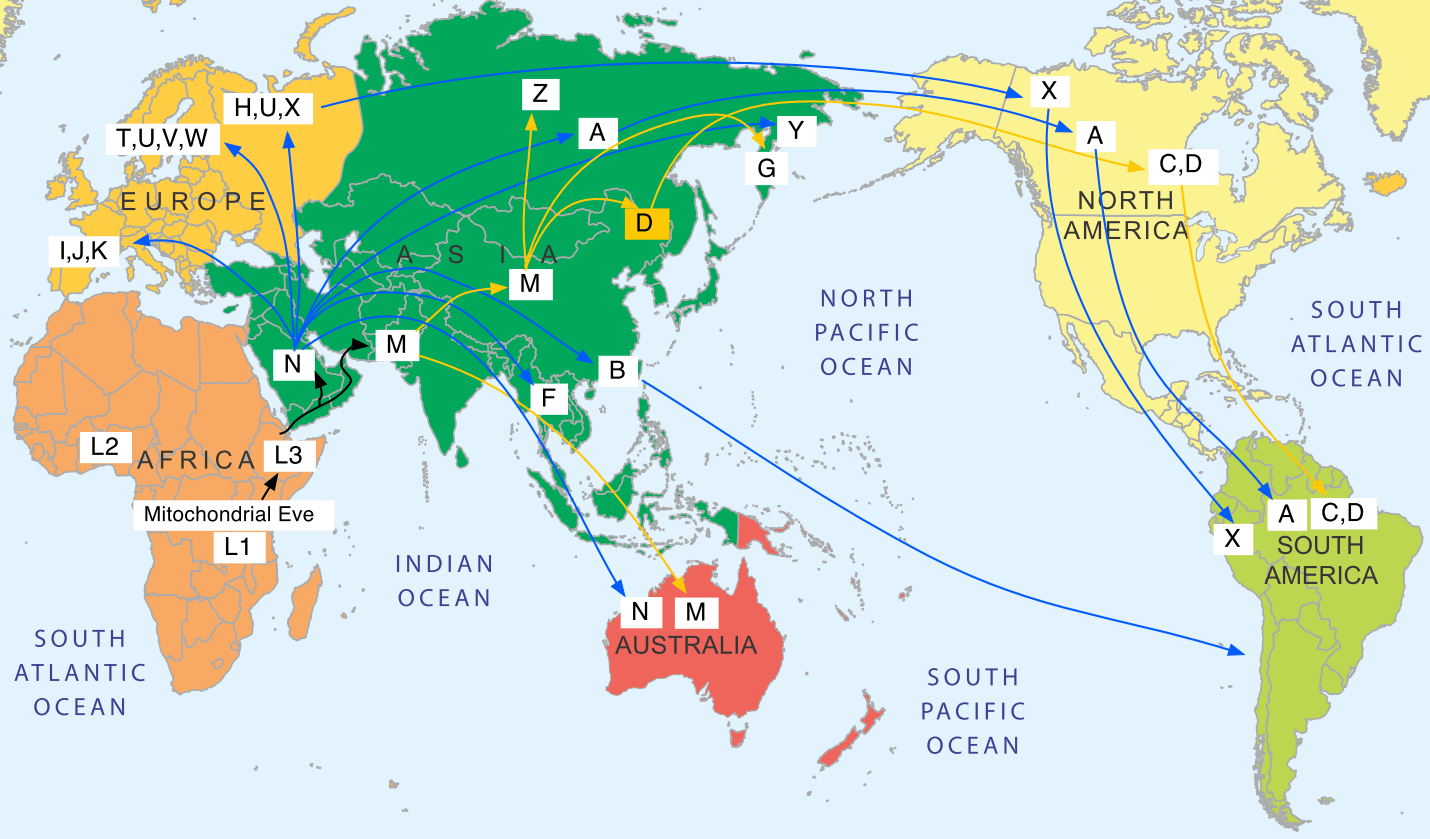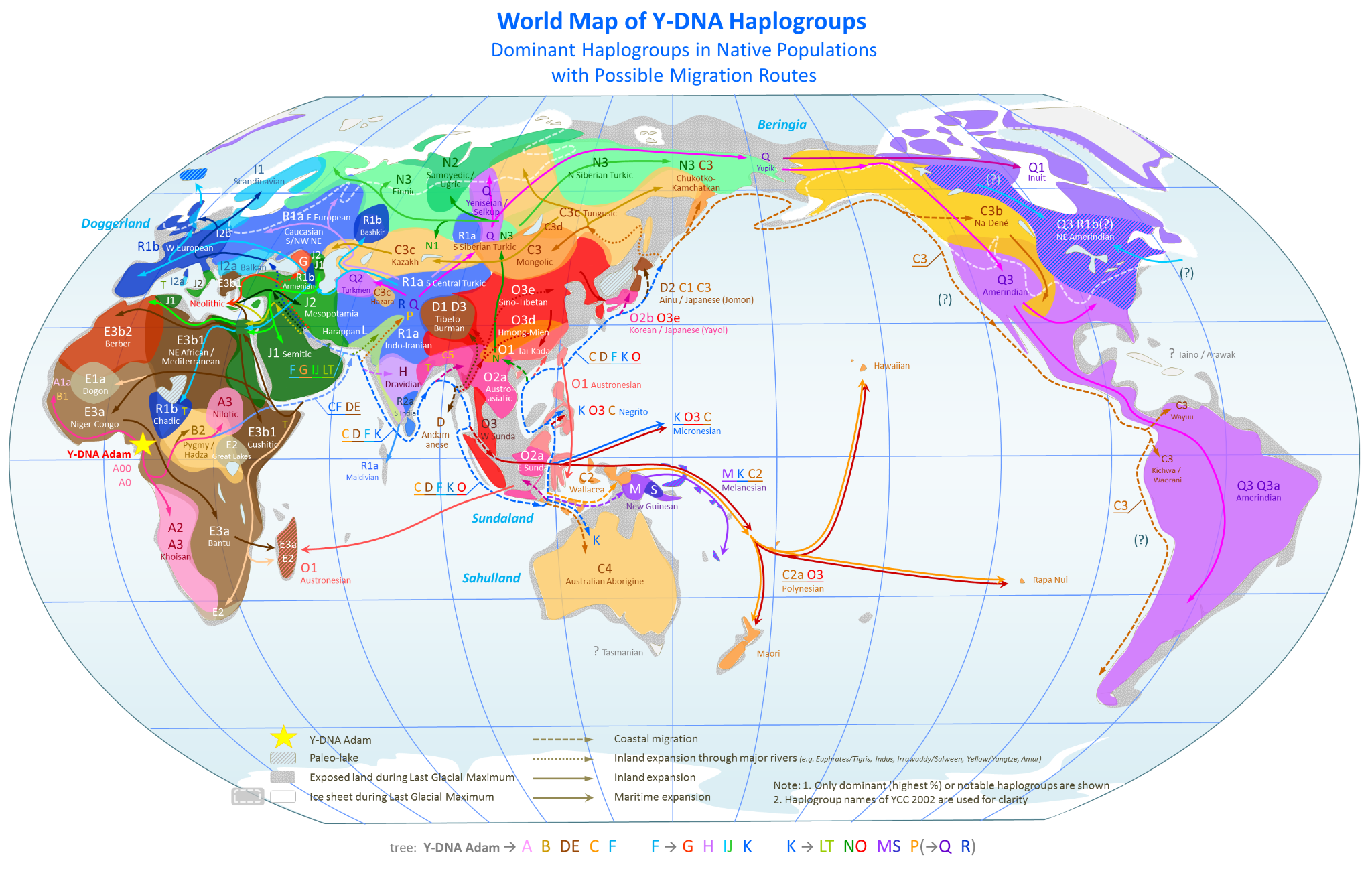What is the Difference Between Y-DNA and mtDNA Haplogroup Maps
Those who have taken DNA tests with certain genealogical websites may have noticed that you are assigned a haplogroup. Depending on your gender this may be a YDNA or a mtDNA haplogroup.
What are these haplogroups and how do they differ? In this post we will take a closer look at haplogroups to help you understand what they mean to you and your ancestry.
AncestryDNA is Our Top Recommendation
After reviewing all of the top DNA products on the market, nothing comes close to AncestryDNA to help you discover your whole family story!
They give you so much more than any other family tree DNA kit, and let you connect to the places you're from in the world where your family story started, and even help you to discover living relatives you never knew you had!
For the most accurate family history research based on your DNA, sign up for AncestryDNA now!
Get AncestryDNA →What Are Haplogroups Maps?
The best place to start is by explaining just what these haplogroups are. Essentially, YDNA and mtDNA haplogroups maps are a way to help chart our deep ancestral origins. When we say deep ancestral origins we really do mean deep.
Our haplogroups help link us to ancestors from thousands of years ago and help us understand where our ancient forebears may have lived originally. This haplogroup information does not really help you get back a few generations but rather 20-30 generations.
It should be noted that it doesn’t connect you to a known ancestor because frankly it is exceedingly rare to get beyond 500 years in the average family tree. Haplogroups can go back many thousands of years.
These maps then are a visual representation of where certain haplogroups likely originated from geographically. So for example if you have a haplogroup that originated in Scandinavia then you very likely have a distant ancestor from that region.
mtDNA Haplogroups
Allow me first to explain a little about mitochondrial DNA (mtDNA). This is the DNA found in every cell of our bodies and we receive this specifically from our mothers. Males and females inherit mtDNA from their mothers but males cannot pass it down to their own offspring.
Because mothers are the only ones who can pass down mtDNA this means that the DNA we hold today has been passed from mother to daughter for thousands of years. This direct inheritance from a single parent means this DNA is never recombined and for the most part is passed down unchanged.

With the DNA not changing this means that the mtDNA we have is very similar to that of our ancient maternal ancestors. There are however occasional mutations which will alter the mtDNA but only in small ways.
These mutations then are how we are able to trace specific haplogroups to certain regions. If our mtDNA was identical to that of the first human female then there would be no variation. Certain mutations that occur can be traced to the native populations of particular regions.
So if you have a mtDNA haplogroup from Asia then your distant maternal ancestor likely originated from that region.
Who Tests mtDNA?
Companies such as Living DNA and 23andMe do test for your basic mtDNA haplogroup when they perform their autosomal testing. This usually results in this discovery of a few of the basic characters that make up your specific haplogroup.
A haplogroup of course is designated using letters and numbers that pertain to details regarding the origin and mutation of that particular line.
If you want to have your full mtDNA haplogroup result you have to take a specific test for that type of DNA. The leading company for this is family Tree DNA who can give you a detailed haplogroup result. These details are the important aspect as it is these subtleties that help pinpoint where your ancestors came from based on specific known mutations.
YDNA Haplogroups
YDNA is also a gender specific type of DNA both in who carries it and who it is passed down from. The Y refers to the Y-chromosome, a sex chromosome only found in males. This means that it can only be passed from father to son in much the same way mtDNA passes from mother to child.
This direct and full inheritance also means that YDNA remains largely unchanged over multiple generations with only very occasional small genetic mutations. As with mtDNA it is these mutations that help us attribute a haplogroup to a specific region.

Who Tests YDNA Haplogroups
As with mtDNA, 23andMe does a basic test for your YDNA so can perhaps offer a few characters of your entire haplogroup. Living DNA tests more of your YDNA that the other autosomal testing companies so will give you a better idea of your actual haplogroup, It is however not a full YDNA test.
Those looking to get a full YDNA test for your haplogroup will want to try one of the options offered by FamilyTreeDNA. If you are female and do not have a Y-chromosome you can still benefit from this testing if you can get your father, his male siblings or your brothers who are descended from him to test instead.
They will have the YDNA that is needed to trace your paternal line even though you do not.
The Haplogroup Maps
The so-called haplogroup maps for mtDNA and YDNA have been created using a great deal of study and massive DNA collection projects. They suggest possible origins for certain haplogroups and also potential migration paths taken by our ancient ancestors.
To the untrained eye it can seem like a jumble of symbols and colorful arrows but with some concentration they are not that complicated to decipher.
The basic take away from both of these types of maps is that the mtDNA Eve and YDNA Adam both seem to originate on the African continent. From there over hundreds of thousands of years both the male and female haplogroups unsurprisingly took a very similar migration path throughout the globe.
Conclusion
Haplogroup maps a great representation of where our ancestors came from and where they may have migrated over thousands of years. They are both very similar for the mtDNA (female line) and YDNA (male line) types.
These tests and maps can’t really help us to definitively identify a great-great-great grandparent but they can tell us something of our ancient ancestral roots.
Link To or Reference This Page
We spent a lot of time downloading, cleaning, merging, and formatting the data that is shown on the site.
If you found the data or information on this page useful in your research, please use the tool below to properly cite or reference Name Census as the source. We appreciate your support!
-
<a href="https://namecensus.com/blog/what-is-the-difference-between-y-dna-and-mtdna-haplogroup-maps/">What is the Difference Between Y-DNA and mtDNA Haplogroup Maps</a>
-
"What is the Difference Between Y-DNA and mtDNA Haplogroup Maps". NameCensus.com. Accessed on April 19, 2024. https://namecensus.com/blog/what-is-the-difference-between-y-dna-and-mtdna-haplogroup-maps/.
-
"What is the Difference Between Y-DNA and mtDNA Haplogroup Maps". NameCensus.com, https://namecensus.com/blog/what-is-the-difference-between-y-dna-and-mtdna-haplogroup-maps/. Accessed 19 April, 2024
-
What is the Difference Between Y-DNA and mtDNA Haplogroup Maps. NameCensus.com. Retrieved from https://namecensus.com/blog/what-is-the-difference-between-y-dna-and-mtdna-haplogroup-maps/.
